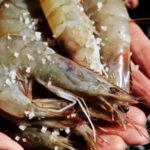Shrimp is a nutritious food that is easy to prepare and appeals to most people’s tastes. However, this seafood is easily spoiled or injected with chemicals, which not only reduces the quality of the food but also affects the health of the consumer. Therefore, housewives need to know how to choose fresh and safe shrimp.
How to choose fresh shrimp
To choose fresh and safe shrimp, you need to observe carefully and evaluate based on the following signs.
Observe the color
Generally, fresh shrimp will have a whitish-green shell and a certain degree of shine. Especially when viewed under the sun, the shrimp shell still feels transparent and shiny. In contrast, shrimp that has been sitting for a long time tend to have a yellow or pale shell.
Different types of shrimp have slightly different color characteristics. However, if you see shrimp turning black, you can be sure that they have been dead for a long time and are decomposing. Eating such shrimp can seriously affect your health.
In addition, you should also know that shrimps that have been peeled are usually shrimp that have been frozen for a long time.

Fresh shrimp are usually curved, have a whitish-green shell, and a certain degree of shine. (Image: Shutterstock)
Check the connection between the head and the body of the shrimp
Shrimps that are fresh will have a slightly curved body, firm flesh, and flexible shell, with the head still firmly attached to the body. If the connection between the head and the body of the shrimp is black, loose, and the head is about to fall off, it means that the shrimp is no longer fresh.
Check the elasticity
Fresh shrimps have high elasticity and quickly regain their shape when squeezed. You can hold a shrimp and try pulling it straight out. If the shrimp does not bend back like its original position, it indicates that it has been dead for a long time and is no longer fresh.
Observe the tail of the shrimp
Check the tail of the shrimp to determine its freshness. Fresh shrimp usually have the tails folded together and pointing downwards.
If the tail spreads out, it indicates that the shrimp has been injected with chemicals or water to make it plump. When cooked, it will release a lot of water, the flesh will shrink, become shriveled, and have a duller taste than normal.
Observe the legs of the shrimp
Fresh and good shrimp have legs tightly attached to the body, and the shrimp meat is firm. You should not buy shrimp with legs that have turned black because this is a sign that they are no longer fresh.
Choose curved shrimps
With frozen shrimps, you will see some curved ones and some straight ones. If possible, choose the curved ones because they are the shrimps that were alive before being frozen. The straight-tailed shrimps have all died before being preserved.
You should try pressing on the body of the shrimp. If the body is firm, it indicates that it was alive before being frozen.
Tips for choosing each type of delicious shrimp
The way to choose fresh and good shrimp for blue shrimps is to choose the ones with bright pink color and the legs still attached to the body. The dark pink shrimps have been preserved for a long time and their quality has decreased significantly.
For prawns, you should buy the ones that are still alive, jump around, have white and pink bodies, and green eyes. The prawns with dark pink shells have usually been dead for a long time.
For white-legged shrimps, you should choose the ones with shiny, smooth shells and the flesh inside is white. These are the delicious and firm shrimps.
To buy good lobsters, you should choose the ones that are still alive, healthy, have green claws, and a fresh outer shell.
How to preserve fresh shrimp
Many people, due to their busy schedule, have the habit of storing food, buying shrimp and preserving them in the refrigerator. When taken out for cooking, the shrimp often turns black. To avoid this, you should buy live fresh shrimp, remove the whiskers, then rinse them thoroughly, and drain the water before preserving them.
After the shrimp is drained, you should put them into a food container and sprinkle some white sugar on top, then shake it evenly. Store the shrimp in the freezer compartment of the refrigerator or freezer at low temperatures. When frozen, the shrimp flesh will not be attacked by bacteria and deteriorate.
The white sugar will help prevent the shrimp head from turning black and the individual shrimps from sticking together. When cooking, you can easily take out each individual shrimp.
Do not store shrimp for too long (preferably less than 30 days) as they will lose their nutritional value over time.
According to VTC News
How to Choose Fresh Seafood: Important Cabinet Tips
In recent years, concerns have been raised over the practice of injecting urea and chemicals into seafood, making it difficult to find safe and fresh options. To help, DienmayXANH.com offers some tips on how to select the best seafood available. Seafood is a rich, delicious, and nutritious source of food, and this advice will help ensure you make the most of it.






































